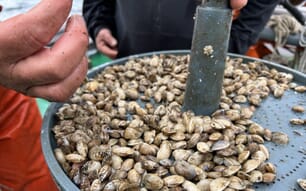The scientific paper, published in the journal Zootaxa, is co-authored by researchers with the Canadian Museum of Nature and Fisheries and Oceans Canada (Bedford Institute of Oceanography).
"This is the culmination of a story that began decades ago when, as a PhD student, I first observed this clam in an underwater submersible off the coast of Newfoundland," explained Dr Jean-Marc Gagnon, Curator of Invertebrates with the Canadian Museum of Nature in Ottawa. "Originally, we assumed it to be a European species."
In recent years, more samples have been collected off the Grand Banks and in a marine protected area "The Gully" about 220 km off the coast of Nova Scotia.
Through DNA analysis coupled with comparative studies of other giant file clams in museum collections, Dr Gagnon and his colleagues determined these north Atlantic specimens to be a new species.
The giant file clam, about 9 to 15 cm long, is two to three times larger than a regular file clam (so-named because of the sharp ridges on the shell surface).
This creature attaches to steep, rocky outcrops in canyons that are home to other deepwater species such as cold-water corals. The clam's scientific name, Acesta cryptadelphe, means "cryptic sibling", which refers to the similarity in shape and structure to the previously described European giant file clam, Acesta excavata.
The story of the identification of this new species is also one of technology says study co-author Dr Ellen Kenchington, a scientist with the Bedford Institute of Oceanography (BIO) in Dartmouth, Nova Scotia.
Scientists from BIO used ROPOS - an underwater vehicle with cameras and manipulator arms - to find new specimens of the clam while operating in the deep-water canyons of the Gully Marine Protected Area.
Before they even returned to their shore labs, the scientists were able to use new genetic technology aboard the oceanographic ship CCGS Hudson to process the DNA from the clams.
"Using all this technology allowed us to photograph and collect intact specimens, and then to process the DNA while at sea. This gave us an early indication that we might have something special," Dr Kenchington said.
"The Gully MPA continues to amaze us with new discoveries. It is an extraordinary place," she added.
When Dr Gagnon first discovered the clams in the 1980s, he recognised that they were unusual, with characteristics similar to scallops, but he put them aside to focus on other research. It was only years later at the museum that he began to look at them more closely.
"We had a limited number of clams to examine, but enough to conclude at the time that they were similar enough in morphology to the European giant clam, and likely represented new northerly records for this known species," explains Dr Gagnon.
Previously, European giant file clams had only been known on this side of the Atlantic from the Caribbean and the Gulf of Mexico.
But when Dr Gagnon received the specimens collected in 2007 and 2010 by Dr Kenchington and her team, he realised they were similar to the giant file clams he had collected in 1984 near Newfoundland.
Along with other specimens uncovered by a Spanish research team off the Grand Banks, Gagnon was able to compare these new specimens to those of the six other known species of giant file clams. More than 150 clams were part of the study.
The results confirmed that shape and structure alone could not differentiate the northwest Atlantic species from the European and other known species. But the new DNA technology and genetic analysis provided by the Bedford Institute showed that the "cryptic" species was genetically distinct from the European giant file clam and is a new species, now known as Acesta cryptadelphe.
"Our persistence shows that there are still discoveries to be made from deep in our oceans, and both museum collections and genetic analysis are important resources to advance this knowledge," said Dr Gagnon.
Top image credit: © Fisheries and Oceans Canada




